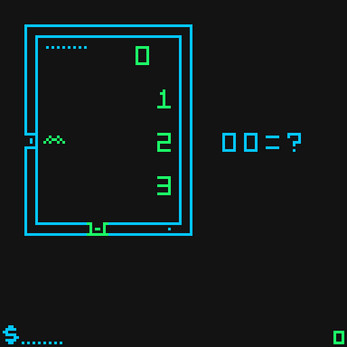Have I woken up inside a computer?
We use a base 10 numerical system in our daily lives, but computers cannot work with them easily. Instead they use a numerical system called binary, which represents numbers with 0s and 1s. This experience allows the user to explore the complete basics of binary on their own, with a little help and guidance along the way if they need it.
When I was younger, I had a mentor, who helped me but also let me make discoveries of my own. If you look close enough, you can see how this game is a tribute to him. I hope others can learn from this game and perhaps find a mentor of their own one day.
Song title: DJ Sona Ethereal
Artists: Nosaj Thing x Pretty Lights
Courtesy of Riot Games (guidelines)
| Status | Released |
| Platforms | HTML5 |
| Author | plougheed |
| Genre | Educational |
| Made with | bitsy |
| Tags | binary, Bitsy, computer-science, learning |
| Code license | MIT License |
| Asset license | Creative Commons Attribution_ShareAlike v4.0 International |
| Average session | A few minutes |
| Languages | English |
| Inputs | Keyboard |

Comments
Log in with itch.io to leave a comment.
The designer uses blue, green, and black in this game of the first few rooms, which makes the player feel like they are really in the environment of a computer. Besides, the green used is very bright. It is easy for players to find out useful items. For example, the problems to be solved and the exits. Considering this game is for students to learn to convert binary to decimal. Cool colors like the color of tile—blue, making children feel calm and not irritable or restless. The background of each room becomes lighter and lighter. It's a great way to tell players you're getting closer to victory. In the last room, the background turns from black to white. It makes me feel like that I've overcome the difficulties and come to the light, leaving the virtual world of the computer and came to the real world at the same time.
There are not very many types of tiles but is easy for players to know the area of operation, helping players have a clear idea of where they should move next in the game. In the last room, the walls on the side are made up of zeros and ones, which fits the theme of the whole game.
The second room which is the first one to choose the answer brought lots of attention to me. It cost me a little time to figure out how to escape from the room. But it is still clear and easy to find the right way to do it.
The designer defined exits in a great way. There are two types of exits: one is the exit to the next room and the other is an “exit” to the outer space beyond the light blue border. The designer uses a different color (light green) and different pattern to specify the first type of exit. It is obvious to players that that specific tile is an exit. As for the second type of exit, which I believe is a “secret pathway”, they are only specified with a dot on the border. It is noticeable to players but I had no idea that I could go past the border before I approached that dot. The transition between rooms is also interesting. The animation of the transition is very sudden, but the designer has a dialogue prepared before each transition. The dialogue simply tells players if they get this level correctly, if so, the avatar will jump to the next room. I believe it moves me in space. Rooms tend to get harder to solve gradually as well. Each room looks similar while they are distinct from each other in detail. In my opinion, the rooms are constructed in both linear plot and an open format. I had no idea what was going to happen in the next room before finishing the first room. As I discussed above, each room shares some similarities yet there are different binary problems that need to be solved. The “beyond the border” element provides players an open format. The avatar can interact with the symbol on the bottom left corner, and each symbol displays different dialogue that show appreciation for the designer’s mentor. It is a smart design full of surprises and details.